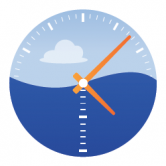
Just why are the tides, and the tide times, different across the UK?
Although the sun and moon influence the tides, the shape of the coastline, water depth and the currents can influence the height and flow rate of the tides and the specific tidal times. The gradient of the seabed near the shore can also affect tides, with both steep gradients and a gentle sloping seabed creating variable differences.
The specific features of a coastal location can affect how water moves, creating a lag that influences the times of the tide and other conditions. These variations give each coastal location a unique tidal pattern. To highlight the variations, the Bristol Channel experiences a very high spring tide range of 12.3 metres, while this is just 1.9 metres in Lowestoft.
Not all UK coastal locations experience two high tides a day. Southampton, for example, experiences a double high water tide, while Weymouth has a double low water tide. Although high spring tides take place at the same time of day every year at each coastal location, this can vary from place to place. In Brighton, for example, expect low spring tides at dawn and dusk, while Torbay will experience low spring tides during the middle of the day. There can be variations in tidal patterns in locations not that far from one another, so always be tide aware when visiting both new and familiar coastal areas.
